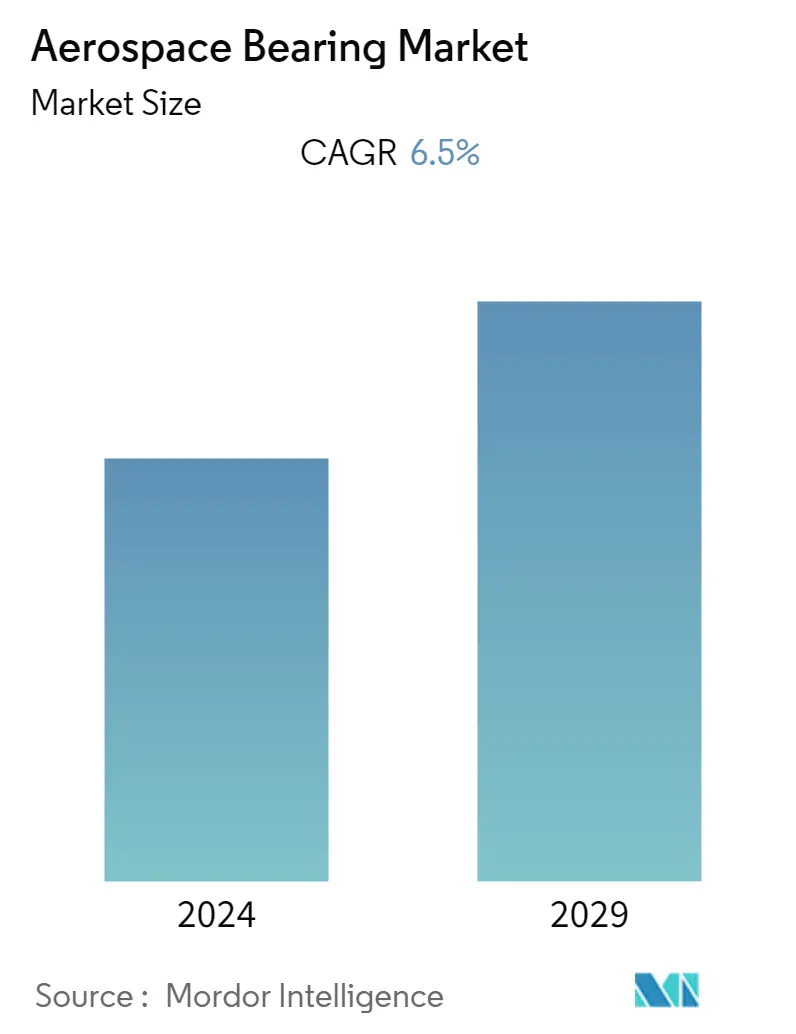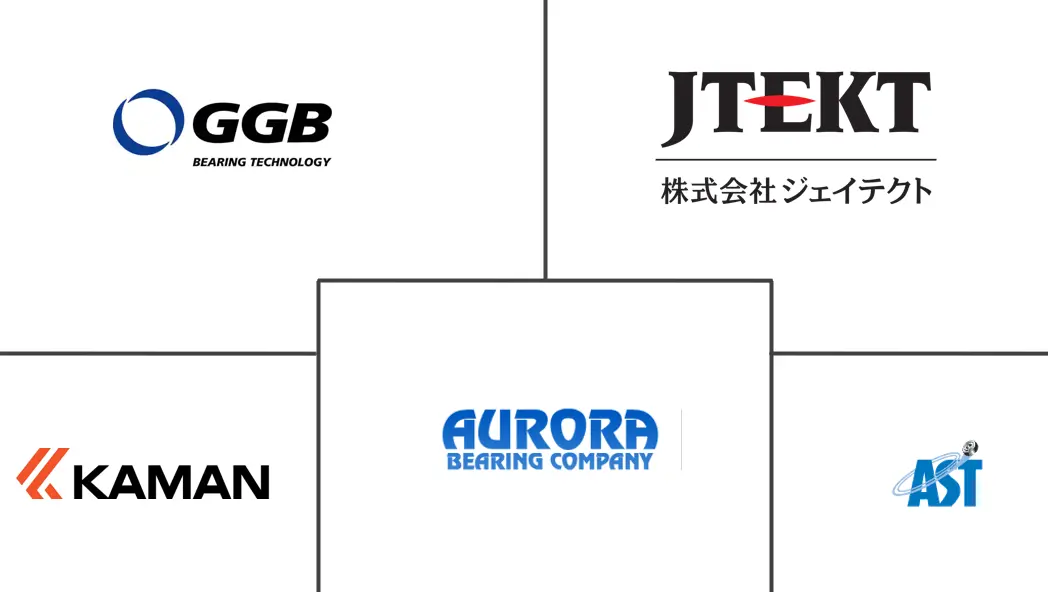Market Size of Aerospace Bearing Industry

| Study Period | 2019 - 2029 |
| Base Year For Estimation | 2023 |
| CAGR | 6.50 % |
| Fastest Growing Market | North America |
| Largest Market | Asia-Pacific |
| Market Concentration | Medium |
Major Players
*Disclaimer: Major Players sorted in no particular order |
Aerospace Bearing Market Analysis
The aerospace bearings market is anticipated to grow at a CAGR of 6.5% during the forecast period.
The pandemic led to various governments imposing stringent regulations and banning the import and export of raw materials, which led to a sudden downfall regarding the valuable parts needed for the manufacturing of aerospace bearing systems. Additionally, manufacturers in various nations were forced to shut down their businesses wholly or partially due to the global lockdown. Furthermore, the pandemic also led to delays in terms of activities as well as initiatives concerning the development of advanced bearing systems. The decline in the COVID-19 pandemic led various governments worldwide to ease up on the stringent regulations which were in place and open up the borders, which led to a free flow of trade and availability of raw materials, parts, and components for manufacturers to resume production and meet the increasing aerospace bearing procurement demand. Thus, this will lead to the market growing steadily in the years to come.
Aerospace bearings require proper care and maintenance for their long run operation. They are crucial to ensure the correct application and installation of aerospace bearings to extend their lifespan. Changing government policies & regulations pertaining to emission standards and climate change goals will also hinder aerospace bearings production in the near term. Moreover, automation, along with condition monitoring and remanufacturing digital services, will reduce scrap rates, increasing energy efficiency and environmental benefits.
Since the past few decades, aerospace bearing has witnessed significant evolvement. The earlier focus on providing lightweight, durable, and reliable bearings has given way to the development of advanced composite-based bearings. Moreover, the newer generation of aerospace bearings is made of various advanced features such as reduction in the weight as well as the space occupied, which enables for minimalistic friction as well as noise, thereby leading to the decrease in terms of maintenance costs of the aerospace bearings. Moreover, such features shall help to increase the efficiency of the bearings and thus help the bearings to operate at minimal costs, thereby leading to growth in the market.
Aerospace Bearing Industry Segmentation
An aerospace bearing is a component used to reduce the load and friction between the moving or rotating parts in an aircraft. Aerospace bearings help in reducing the axial as well as radial load and improve fuel efficiency. Moreover, aerospace bearings also help reduce the maintenance of aircraft. Different types of bearings, such as roller bearings, ball bearings, and plain bearings, are used for different applications.
Aerospace bearings are used in all types of aircraft, including narrow-body aircraft, wide-body aircraft, freighters, and regional jets. A bearing in an airplane is primarily used to reduce the radial and axial force directly applied to shafts. Aerospace bearings also facilitate easy movement of doors, seats, flight control components, and engine management systems without any failure.
The aerospace bearings market is segmented by platform, product type, application, and geography. The market is segmented by platform: fixed-wing, rotary-wing, and UAV. By product type, the market is segmented by plain bearings, roller bearings, ball bearings, roller screws, and ball screws. By application, the market is segmented into the engine, aero structures, landing gear, and others. The report also covers market sizes and forecasts of different geographical regions. Moreover, the report offers a market forecast represented by USD million. Furthermore, the report includes vital statistics on the market status of leading market players and provides key trends and opportunities in the aerospace bearing market.
| By Platform | |
| Fixed-wing | |
| Rotary Wing | |
| UAVs |
| By Product Type | |
| Plain bearings | |
| Roller Bearings | |
| Ball Bearings | |
| Roller Screws | |
| Ball Screws |
| By Application | |
| Engine | |
| Aero-Structures | |
| Landing Gear | |
| Other Application |
| By Geography | |||||||
| |||||||
| |||||||
| |||||||
| |||||||
|
Aerospace Bearing Market Size Summary
The aerospace bearings market is poised for steady growth, driven by the resumption of trade and production activities following the easing of pandemic-related restrictions. The market is characterized by the evolution of aerospace bearings, which have transitioned from traditional designs to advanced composite-based systems. These modern bearings offer benefits such as reduced weight, minimal friction, and lower maintenance costs, contributing to their increasing adoption in the aviation sector. The market's expansion is further supported by the development of automation and digital services that enhance energy efficiency and environmental sustainability. However, challenges such as changing government regulations related to emissions and climate goals may impact production in the near term.
The North American region is expected to experience significant growth due to the presence of major aircraft OEMs and component manufacturers, alongside increased military spending. The demand for new and reliable aerospace bearings is rising, driven by various applications in aircraft assembly. Key players in the market, including AST Bearings, Aurora Bearings, and GGB Bearings Technology, are focusing on innovation and strategic partnerships to enhance their product offerings and maintain market dominance. The ball bearing segment, known for its versatility and durability, is anticipated to witness substantial growth, with applications spanning air circulation systems, navigation tools, and more. These developments underscore the market's potential for expansion during the forecast period.
Aerospace Bearing Market Size - Table of Contents
-
1. Market Dynamics
-
1.1 Market Overview
-
1.2 Market Drivers
-
1.3 Market Restraints
-
1.4 Industry Attractiveness - Porter's Five Forces Analysis
-
1.4.1 Threat of New Entrants
-
1.4.2 Bargaining Power of Buyers/Consumers
-
1.4.3 Bargaining Power of Suppliers
-
1.4.4 Threat of Substitute Products
-
1.4.5 Intensity of Competitive Rivalry
-
-
-
2. Market Segmentation
-
2.1 By Platform
-
2.1.1 Fixed-wing
-
2.1.2 Rotary Wing
-
2.1.3 UAVs
-
-
2.2 By Product Type
-
2.2.1 Plain bearings
-
2.2.2 Roller Bearings
-
2.2.3 Ball Bearings
-
2.2.4 Roller Screws
-
2.2.5 Ball Screws
-
-
2.3 By Application
-
2.3.1 Engine
-
2.3.2 Aero-Structures
-
2.3.3 Landing Gear
-
2.3.4 Other Application
-
-
2.4 By Geography
-
2.4.1 North America
-
2.4.1.1 United States
-
2.4.1.2 Canada
-
-
2.4.2 Europe
-
2.4.2.1 Germany
-
2.4.2.2 United Kingdom
-
2.4.2.3 France
-
2.4.2.4 Rest of Europe
-
-
2.4.3 Asia-Pacific
-
2.4.3.1 China
-
2.4.3.2 India
-
2.4.3.3 Japan
-
2.4.3.4 Australia
-
2.4.3.5 Rest of Asia-Pacific
-
-
2.4.4 Latin America
-
2.4.4.1 Mexico
-
2.4.4.2 Brazil
-
-
2.4.5 Middle East and Africa
-
2.4.5.1 United Arab Emirates
-
2.4.5.2 Saudi Arabia
-
2.4.5.3 South Africa
-
2.4.5.4 Rest of Middle East and Africa
-
-
-
Aerospace Bearing Market Size FAQs
What is the current Aerospace Bearing Market size?
The Aerospace Bearing Market is projected to register a CAGR of 6.5% during the forecast period (2024-2029)
Who are the key players in Aerospace Bearing Market?
AST Bearings, Aurora bearings, GGB Bearings Technology , JTEKT and Kaman Speciality Bearings are the major companies operating in the Aerospace Bearing Market.

